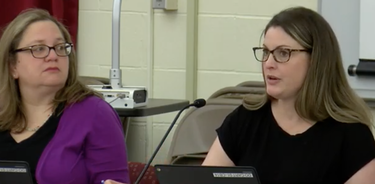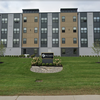Despite hiccup, GCSD board adopts $110M budget proposal
GUILDERLAND — Despite a last-minute recalibration, the school board here unanimously adopted a $110 million spending proposal for next year.
Voters have their say on May 17.
Assistant Superintendent for Business Neil Sanders explained to the school board on April 12 that, although the bulk of state aid came in as the district had anticipated once the state budget was finalized, $308,000 in expected revenue wouldn’t be forthcoming and had to be made up to keep Guilderland’s budget balanced.
The missing funds were for debt incurred by the district with the capital project that voters had approved in 2019.
“We made a late decision … on whether we could get projects finished in time to get aid this school year,” Sanders told the board, stating that material delivery delays and supply-chain issues had dragged out the project “longer than we thought.”
Consequently, he said of submitting paperwork to the state, “We took the safer route and put it off a year,” Sanders said, so the state removed the aid “as they should.”
Sanders said he should have caught that removal sooner and notified the board earlier “so for that I apologize,” he said.
He then itemized a list of savings that would keep the spending proposal close to what it had been.
This included shifting about $100,000 in expenses — for custodial equipment, elementary-school furniture, and replacement musical equipment — to be covered instead by federal funds meant to help schools in dealing with the pandemic.
It also included knowing more precisely, since the April 1 deadline has passed, which special-needs students will require transportation to out-of-district programs next year. Six currently-contracted bus runs won’t be needed, Sanders said, while two new runs will be needed for a net savings just shy of $60,000.
Finally, Sanders referenced the “larger than normal” special-education private placements for next year. In March, while presenting her draft budget, Superintendent Marie Wiles had said that, with new special-education students moving into the district, private special-education costs were expected to go up $1,129,440.
On April 12, Sanders said, “As time has gone on, we’ve been able to look at those students closer and decide on placement.” Three students can be taught in-house at no additional cost to the district, he said, for a savings of $135,000.
“We’re almost back to the same spot as where we were,” Sanders concluded, noting that the tax levy increase remains the same, at 2.98 percent, still under the state-set cap. The increase from last year’s budget is slightly lower, at 4.68 percent, as is the budget total at $109, 887,845.
“Would we find this money for other things if this hadn’t happened?” asked board President Seema Rivera.
“We would still have been in the same place … It’s a timing issue,” Sanders responded.
Board member Kim Blasiak cited the “fiduciary responsibility” of board members and said she was concerned because board members had asked for certain things — Blasiak herself had asked for more counselors and social workers — and board members “were told there’s no wiggle room and now all of a sudden we’re able to find that.”
She also said, “Our ThoughtExchange shows that parents are looking for smaller class sizes.” Alluding to federal funds that would now be spent on custodial equipment and furniture, Blasiak said of spending funds to add staff to bring down class size, a request that hadn’t been granted, “It’s COVID-related that these kids missed out. They were virtual for almost two years.”
Board member Kelly Person was concerned about having less federal money to spend. “We’re taking more out of the federal funds than we anticipated this year,” she said.
Sanders noted that the federal funds will extend for two more years.
Board member Blanca Gonzalez-Parkers asked if unused federal funds would have to be returned.
Wiles said that was true but assured her the district would spend its entire allotment of federal funds. She said a chart was being assembled to show how the funds are being spent.
Federal funds
At the school board’s budget workshop on April 5, Wiles and Sanders went over the federal funds Guilderland is receiving to help with pandemic-related issues.
So far, the district has spent about $1.6 million out of the roughly $7.8 million it has been allocated in federal funds.
The funding is from two different sources:
— $4,995,166 from the Coronavirus Response and Relief Supplemental Appropriations Act, known as CRSSA, which is for costs incurred from March 13, 2020 to Sept. 30, 2023. The purpose is “to prevent, prepare for, and respond to COVID-19.”
The funds can be used to make the educational system better for students, staff, and the community; to address the impact of lost instructional time; or to address already existing challenges that would impede recovery from the pandemic; and
— $2,807,951 from the American Rescue Plan, for costs incurred from March 13, 2020 to Sept. 30, 2024. The money is to be spent on reopening and operating schools safely and on meeting students’ social, emotional, mental health, and academic needs resulting from the pandemic.
Schools are required to spend at least 20 percent of the American Rescue Plan funds on learning loss, using evidence-based interventions and addressing the disproportionate impact of COVID-19 on underrepresented student subgroups.
Sanders stressed that the funds were one time only and were to address short-term needs caused by the pandemic. “We could be left in a difficult and precarious situation,” he said, if funds were used otherwise.
Wiles then presented what she called a “snapshot of what we’ve been doing so far with federal funds.” She said the spending will continue to be “fine-tuned” to meet student needs.
The biggest single expense has been $507,906 for teachers to provide additional services.
Other instructional expenses have been: $115,148 so elementary teachers could eat lunch with students in their classrooms; 96,249 for an end-of-day homeroom period at Farnsworth Middle School; $74,153 for tutoring; $67,560 for special-education teaching assistants; $53,056 for a counselor; $15,000 for P.M. School at the high school, which used to be used by students who couldn’t attend classes for health or disciplinary reasons but has been “very busy this year,” said Wiles; $10,800 for teachers leading the Positivity Project; and $949 for summer curriculum.
Non-instructional expenses have been $52,123 for a floating nurse, $29,390 for teacher’s aids, and $20,900 for nurses performing COVID-related duties.
Purchased services include $20,000 for professional development and $7,230 to transport homeless students. Also, the Board of Cooperative Educational Services was paid $66,415 for communication services.
Because of COVID, Wiles explained, she has been communicating with families twice weekly and the district has also had help with social media platforms.
“All of these are addressing immediate current needs,” Wiles concluded.
Sanders then went over the federal dollars that had been or will be spent on equipment and on remodeling.
Equipment expenses include: classroom books at $84,972; Chromebooks at $43,200; musical instruments at $11,554; musician masks and instrument covers at $8,169; wood planers for high school technology classes at $5,689; weight-room equipment at $5,362; and calculators for math classes at $3,345.
Outdoor learning spaces are allocated $420,000 for a pavilion at each school, Sanders said, and another $350,000 is to repair and upgrade heating, ventilation, and air-conditioning systems.
Noting that the district still has over $6 million in unspent federal funds, Sanders said, “So there’s still a good margin left in those funds.” He stressed that the goal is to get students “back on track.”
Wiles said that school leaders are keeping lists of requests to meet student needs as they unfold. “We’re getting a handle on: What is the distance we need to close and how best to do it,” she said.
She also said, “This funding has come in several buckets” with “rules changing mid-stream.” “It has been a real ball of yarn, or several balls of yarn all tangled up together,” said Wiles.
In the 2021-22 school year, Wiles said, the goal was to “respond to needs immediately before us and then take stock of what’s left and then what are the most pressing needs that we can fulfill over the next two years in ways that won’t necessarily create a strain on the operating budget on the other side of all of this.”
Altamont librarian
At the start of the April 5 workshop, Sanders said he had found a way to add hours to the librarian post at Altamont Elementary School next year to bring it to parity with the district’s other schools.
Several parents and community members had expressed concerns that Altamont, the smallest of the district’s five elementary schools, has just a part-time librarian while the other schools each have a full-time librarian.
Altamont’s principal, Peter Brabant, said he had advocated for having eight-tenths, rather than the current six-tenths, of a librarian post, which would make the librarian-to-student ratio the same as the other schools.
Sanders had calculated the salary “breakage” for four clerks and a custodian — he explained that hiring new people for those posts next year would save money since new hires typically cost less — totalling the $13,600 needed to hire two-tenths of a librarian for Altamont.
“You made a decision that will make a difference in the lives of children and I appreciate it,” Brabant told the board.



